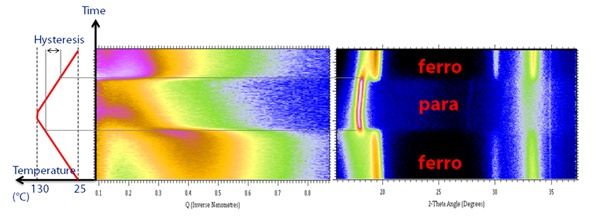We at Xenocs see a growing interest from our user community for performing environmental studies with in-situ, simultaneous SAXS and WAXS measurements (SWAXS). Of course, synchrotron experiments are necessary for studying extremely fast dynamics (a second or less). However, a large range of useful experiments seem possible in the laboratory where exposure times as low as one minute, or less, are accessible through latest developments in X-ray source, optics and hybrid photon counting pixel detectors from Dectris, Switzerland. Smart integration of these technologies using dual detector configurations with a SWAXS module as in both the Xeuss 2.0 and Nano-inXider enable simultaneous small and wide angle data collection without having to change sample-to-detector distance. Thus the same environmental conditions are ensured, which could be particularly beneficial for fast experiments with unambiguous results.Â
Below is an example of an in-situ SWAXS measurement performed on a 20 μm solvent cast P(VDF-TrFE) film to study the phase transition of the first heating above Curie temperature. These measurements on this electro-active polymer were performed on the Xeuss 2.0 in collaboration with Piezotech-Arkema and ESPCI Paris (France) (S. Tencé-Girault and F. Bargain). The short x-ray acquisition time of 1 min compatible with DSC measurements of 1 °C/min enables the detection of a sharp phase transition (from a ferro-electric to a para-electric phase with a transition to a modified ferro electric phase when returning to ambiant temperature). Moreover, the measurement emphasizes an irreversible change of the nanoscale structure with an increase of the characteristic dimension of the ferroelectric phase upon cooling back to the ambient temperature. This unexpected hysteresis effect emphasizes the requirement of a real-time SWAXS measurement. This type of measurement is particularly beneficial to establish a scenario for chain transformation and change of crystallization, in combination with DSC which could lead to improvement of material performances, like ferroelectric material properties in this case.
Please feel free to contact Xenocs for further application examples (in the field of polymer crystallization, gel surfactant, organic thin films as few examples) of temperature studies or other environmental experiments (like humidity or strain).
Â
In-situ SWAXS measurement of a 20 μm thick solvent cast film of P(VDF-TrFE) during a temperature cycle with heating from 25°C to 130°C (above Curie transition) and then cooling down to ambient as shown on left part of the graph. X-ray exposure is 1 min and heating/cooling rate is 1 °C/min.
Â



































